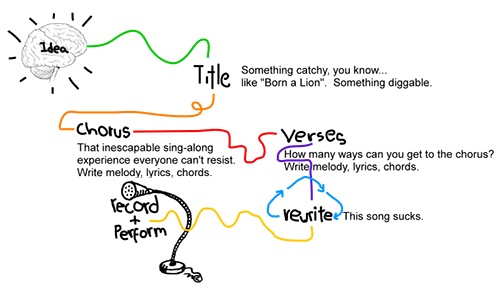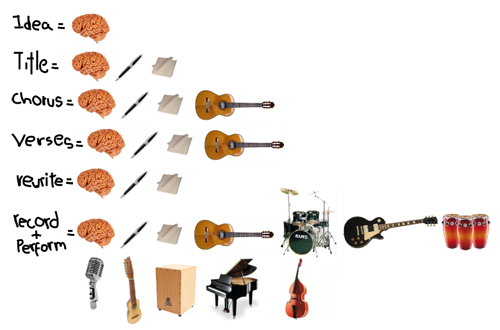case study
The Case Against Using Your Head
I’m an amateur singer-songwriter when I’m not at work or asleep (let’s say for now that they’re mutually exclusive), and for the last few years I’ve been writing and performing material with different bands, duos, and on my own. Throughout that time I’ve tried different things to get my songs from pen and paper to studio and stage. It’s a typical creative process – start with an idea, work, work, work, end with a performance or a recording or both. For the longest time, my process for getting from point A (“Mmmm…good idea…”) to point B (“We’re going to play a song for you called…”) was pretty straightforward.
It looked like this:

The whole thing felt a bit tedious from time to time, but overall, it was working for me, you know. I was successfully getting to the record and perform part of things often enough that it was enjoyable.
So a few weeks ago I had this tremendous breakthrough. I had an idea for a song, and it occurred to me that maybe I should just skip all the other steps and just record it. I know, I know, it sounds crazy.
So I started a recording session and laid a bunch of stuff down. I laid down some cajón (Latin percusión standard fare), some Ladysmith Black Mambazo-esque backup vocals, and some wannabe flamenco guitar. I had no idea what words I was going to sing into the mic, but once I had all that textured music goodness backing me up, words just came out of my mouth. I came up with enough material to fill a couple of songs, actually, just singing into the mic over that loop of sweetness.
For a while after that experience, I thought I had just turned the whole process upside down, and I wondered why it had worked so well. That got me to thinking about the process itself and the mediums I used throughout:

I realized that music (the fun part!) wasn’t showing up enough in the process, and most of it was at the very end. I was doing way too much to come up with stuff in my head, and then following that up with too much pen and too much paper. I suppose that’s partly because I wanted to write songs that were well thought through. I wasn’t interested in writing the next “MmmBop”, and so I thought things through and through and through and through before actually making music.
Thinking is not the problem here, trust me. Thinking is too often what’s lacking from popular music. The problem is the medium I was using for thinking. In this case, my target medium was music – guitar, vocals, yelling, whistles, sound samples – and my primary thinking medium were brain sparks and pen and paper.
Not that brain sparks and pen and paper aren’t decent ways to think, you know, they’re great. It’s just that they’re not the most effective thinking mediums if your target medium is something else. In my case, I needed to use music as my thinking medium if I wanted to write a song, and that’s what I did by recording first. If you’re a carpenter, your best thinking medium is wood. If you’re a writer, it’s a Mac. If you’re a lawyer, it’s b.s. and the more you use your target medium as a thinking medium, the more effective your thinking becomes.
The reasons for this are several, but the most obvious is that if your thinking uses your target medium, your thoughts will have the same essential characteristics, restraints, and properties as your final product. Thus, your synthesis will be more accurate. Additionally, your evaluation will be more intuitive because it’s easier to respond to a blown glass object in blown glass form as opposed to brain spark form.
In design we have a word for thinking in non-brain-spark mediums – prototyping. We talk about it, we like it, we love it. But do we do it enough? How many activities are we undertaking with brain-spark power alone? How many more do we limit to the realm of pen and paper? How many of our thoughts actually make it to prototype form?
I think it’s only a select few. And that’s for the same reason that only a select few of my song ideas were making it to recorded format. See, I thought of recording as a way of presenting; a way to say “ah, now that I’ve done my thinking, let me show you all what I came up with” and then attempting to impress. I think too often we regard prototypes in the same way. We use them to show our client some great idea for a solution. We use them to show our team that we bring something to the table. We use them in our portfolios to say “see? I’m good at this”.
Prototyping is a great medium for presentation, and I’m not knocking it in that capacity. All I’m saying is that it’s so much more than a presentation medium. It is our most powerful thought medium.
When we face design problems, we often do so by attempting solutions (Lawson). However, far too often we attempt them only in our minds. We analyze, synthesize, and evaluate using brain sparks. We brain-spark a solution to life and then brain-spark it to death when its weaknesses occur to us. Later, we forget that we had brain-sparked that solution and return to it, only to discard it once again. How many of us have gone through that cycle time and time again in the limited realm of our minds?
Our thinking process would be far more effective if we used prototypes as a medium for thought – without reverence, without censorship, without that little voice in your head that tells you it should look better than it does because you’re going to show it to someone. We should use it as a medium to analyze the design problem, to propose solutions, to make mistakes, to fix them, and to try new things. We should make them an extension of our brains and use them as such: divergently, creatively, exploring the possibilities for a solution. We should let them replace brain sparks as a thought medium as much as possible.
By using prototypes as a thought medium we’re more likely to have a meaningful, fruitful conversation with our own ideas. We are more likely to better identify their strengths and flaws, and communicate those to others. We are more likely to think about our design problem and its solution candidates accurately. In the end, this kind of thinking is more likely to lead to an effective solution.